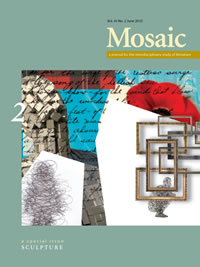Issue 43.2
Overview

Special Issue: Sculpture
Published: June 2010
View the issue introduction or see the issue summary and contents below.
12 essays, totalling 224 pages
$24.95 CAD
According to Hegel, since it transforms mere stone or wood into the human figure, sculpture constitutes the proper centre of classical art and is at best complemented by poetry. What has happened that enables Arthur Danto to suggest that sculpture is postmodernism’s privileged form? This stunning special issue provides answers and provokes new questions for literary and critical theory. The issue, rich in images, includes essays on the work of Marilène Oliver, Kitahara Hakushū and Suda Yoshihiro, Doris Salcedo, Antony Gormley, Sylvia Wynter and Willie Bester, Anna King and Valerie Gillies, Constantin Brancusi, and Patricia Cronin.
Among Other Things; or, Sculpture Beyond IdentityNikolai Duffy This essay considers the status of the image, questions of corporeality, and the ethical dimension of aesthetic practice in the work of the contemporary sculptural artist Marilène Oliver. Drawing on Blanchot’s discussions of the image, Nancy’s analysis of the body, and Levinas’s sense of “escape,” the essay suggests that Oliver’s sculptures expose and challenge contemporary tensions between ethical and bio-political modes of existence. | |
The Weed Chiseling Space: Between Kitahara Hakushū and Suda YoshihiroDennitza Gabrakova The image of a weed becomes a hinge between two unimaginably disparate artistic spaces: Kitahara Hakushū’s poetic interiority and Suda Yoshihiro’s art installations. Such intersection of “modern” poetry and “postmodern” art is (de)conceptualized through Suda’s technique of carving weeds out of wood, thus re-sculpturing the perceptual space of the modern. | |
Inner SpaceAlphonso Lingis Antony Gormley’s sculptures do not depict bodies in narrative positions and rhetorical gestures. Instead, they present the inner space of the body and induce in the viewer both an awareness of the inner space of the works and an awareness of the inner space of his or her own body. | |
Brancusi’s Gate and the Kiss of LifePeter Stix Brancusi’s 1938 Gate of the Kiss, initially designed during or shortly after World War I, revolutionized the design of war memorials. Its human scale, overall simplicity, and symbolic imagery are designed to put an end to the tradition of triumphal arches and, by extension, wars and their destructiveness. | |
Close Closer Closest: Re-envisioning Sculpture and Poetry through CraftLaura Severin This essay examines fibre artist Anna King and poet Valerie Gillies’s joint 2007–2008 Edinburgh exhibition Close Closer Closest. The piece crosses the “high” arts of sculpture and poetry with the feminized art of craft in order to remake Scottish history, and, in the process, reveals the power of boundary-crossing collaborations. | |
Parody as Political Tool in Patricia Cronin’s Memorial to a MarriageKeri W. Watson This essay approaches Patricia Cronin’s monumental funerary sculpture, Memorial to a Marriage, as a politicized piece that employs parody to disrupt the conservative memorial tradition while simultaneously opposing the ban on same-sex marriage and the subsequent marginalization of the lesbian, gay, bisexual, and transgender communities. | |
“Troubled Materiality”: The Installations of Doris SalcedoLaura Garcia Moreno In her early installations, contemporary Colombian sculptor Doris Salcedo re-signifies damaged domestic objects in ways that trigger processes of memory and mourning. They thus acquire the potential to perform profanatory acts, which Giorgio Agamben understands as a way of returning things to human use and potentiality in our time. | |
Science Quarrels Sculpture: The Politics of Reading Sarah BaartmanKatherine McKittrick This essay reviews theoretical analyses of Sarah Baartman, a key figure in scholarly studies of biological determinism and gender difference. Positioning the insights of Sylvia Wynter alongside the sculpture Sarah Baartman by Willie Bester, a creative and politicized engagement with scientific knowledge is explored. | |
Parque dos Poetas/Poets’ Park: The Interplay of Stone and Words in Public SculptureAlbert Braz, with photographs by Jonathan Braz This essay examines the interplay of stone and words in Parque dos Poetas, or Poets’ Park, a Portuguese sculpture garden devoted to twentieth-century poets. It focuses particularly on the aesthetic and social functions of public art and on the relation between artist and work. | |
The Artist as Collector: Blair Brennan and Viewer-Constructed MeaningMegan Bertagnolli Objects retain, through indexical traces, resonances of their former lives, and it is these resonances that are the foundation of artist Blair Brennan’s practice. Guided by how Brennan, and other Canadian artists engaging with collections, then choose to display their collected objects, this essay considers how the spaces between those objects invite a multiplicity of potential readings and viewer-created narratives. | |
An Ideal Solution: Sculptural Politics, Canada’s Vimy Memorial, and the Rhetoric of NationalismDennis Duffy Walter Allward’s Vimy memorial marks a moment in the development of Canadian nationalism when the losses of World War I reinforced what had already become an established tradition in our cultural discourse: the definition of the nation in terms of idealized abstraction. The sacred space defined by the memorial suited the aims of both artist and public, who preferred an eclectic mixture of traditional motifs to a modernist meditation on the fact of mass death. | |
Creating Ruins: Image and Object in Making Unwearable ClothingKathleen Vaughan Exploring the making of a series of Unwearable textile sculptures as a work of mourning and reclamation, this essay links personal text and theory—interweaving aspects of domestic photography, fashion theory, cultural studies, and literary deconstruction—in describing the works’ search for form, from photography to sculpture and back again. |